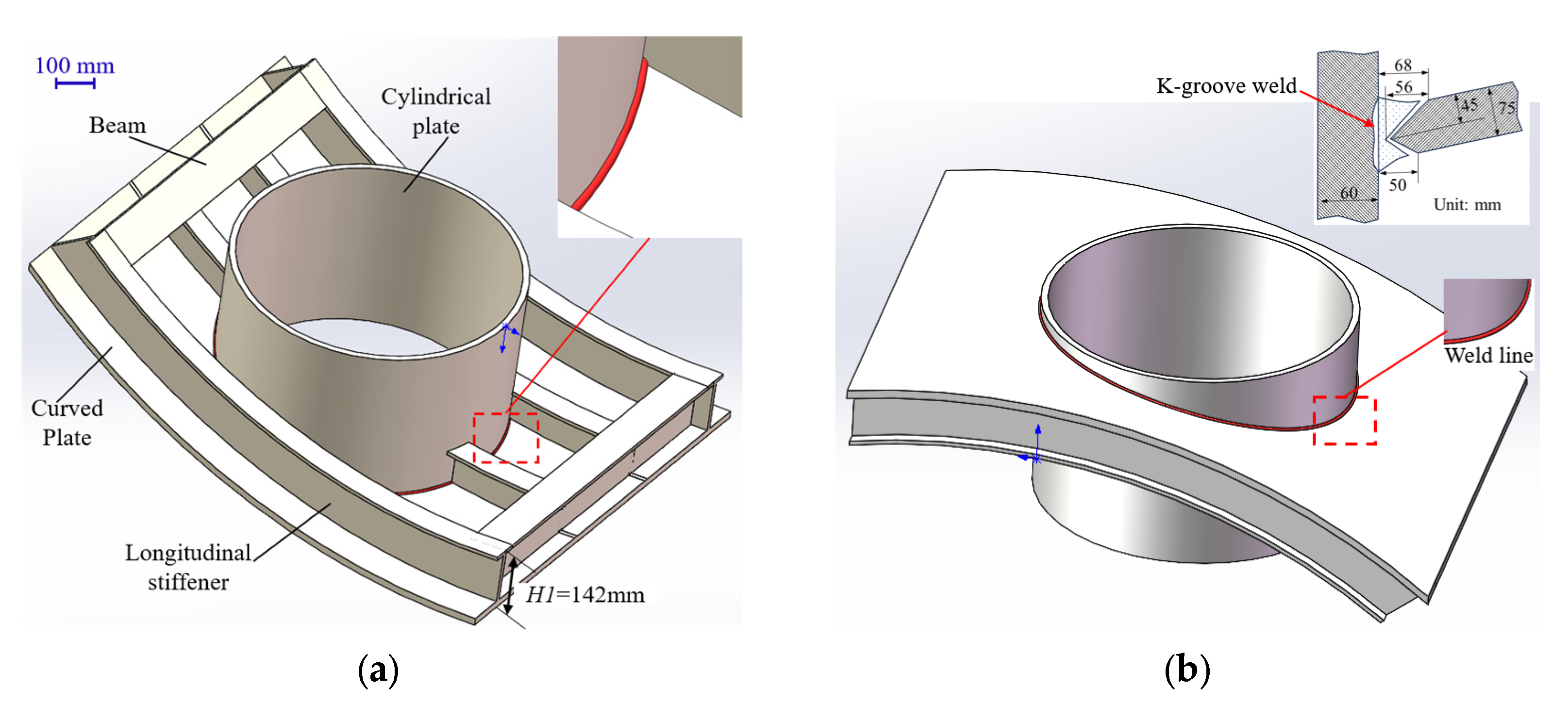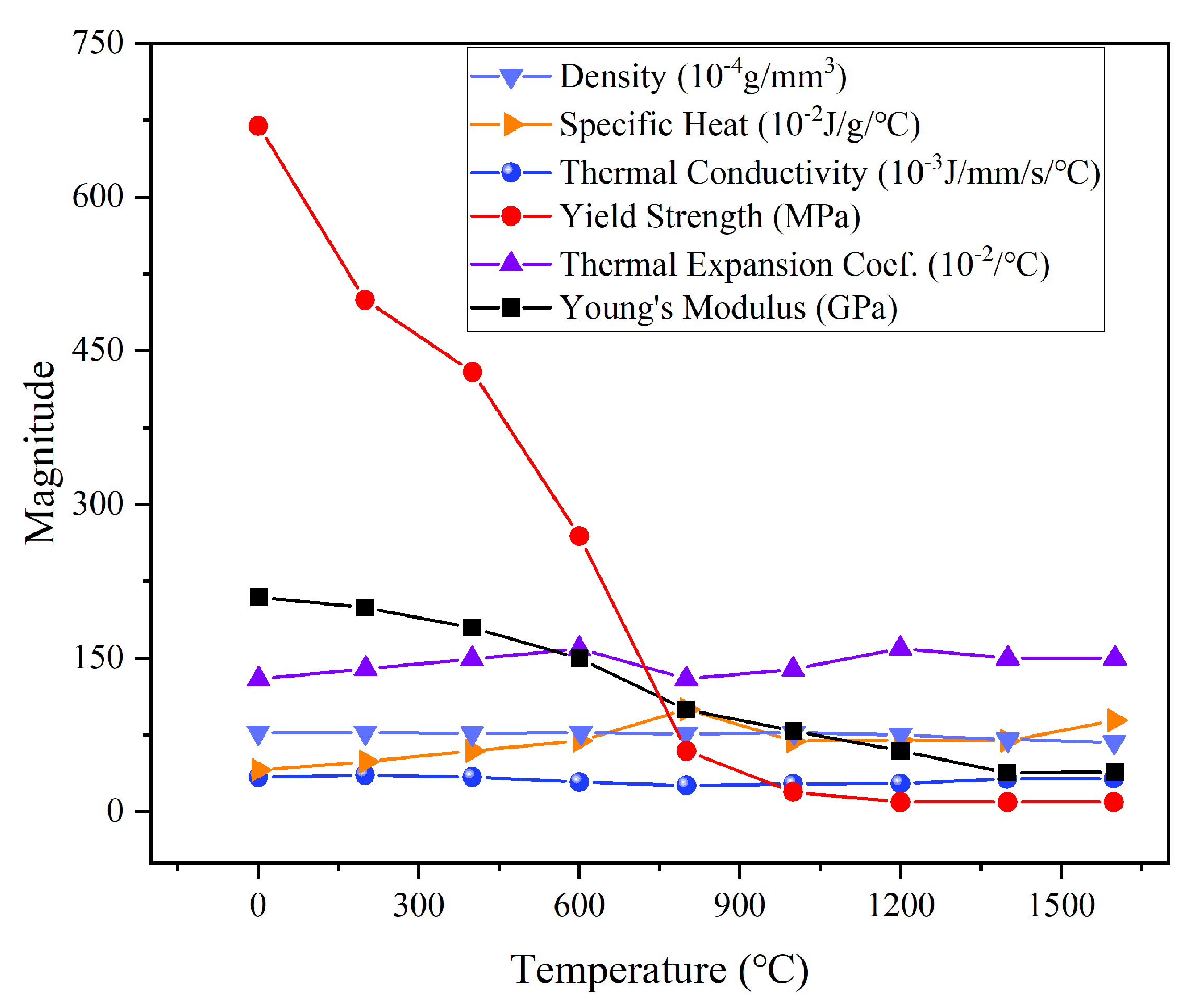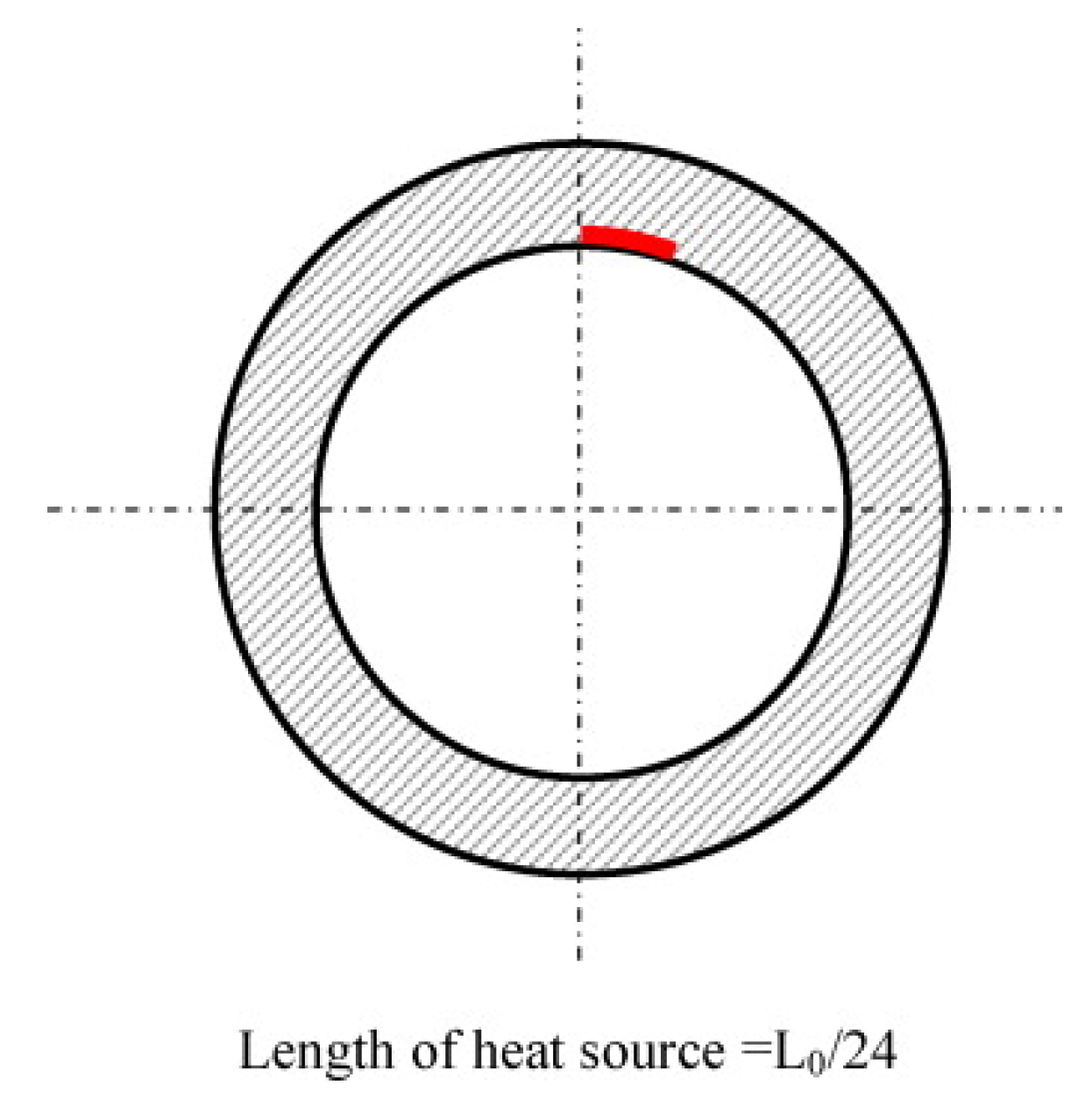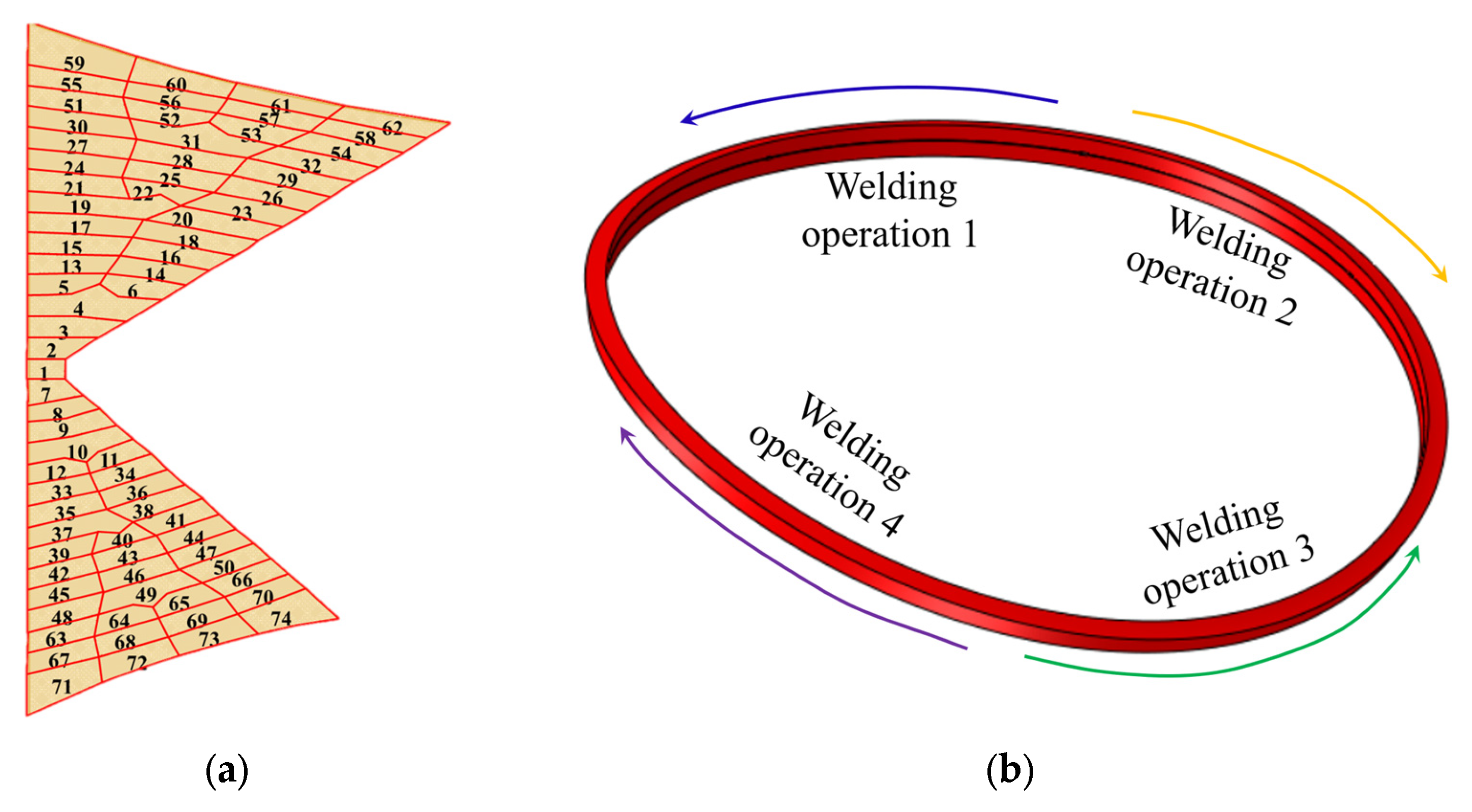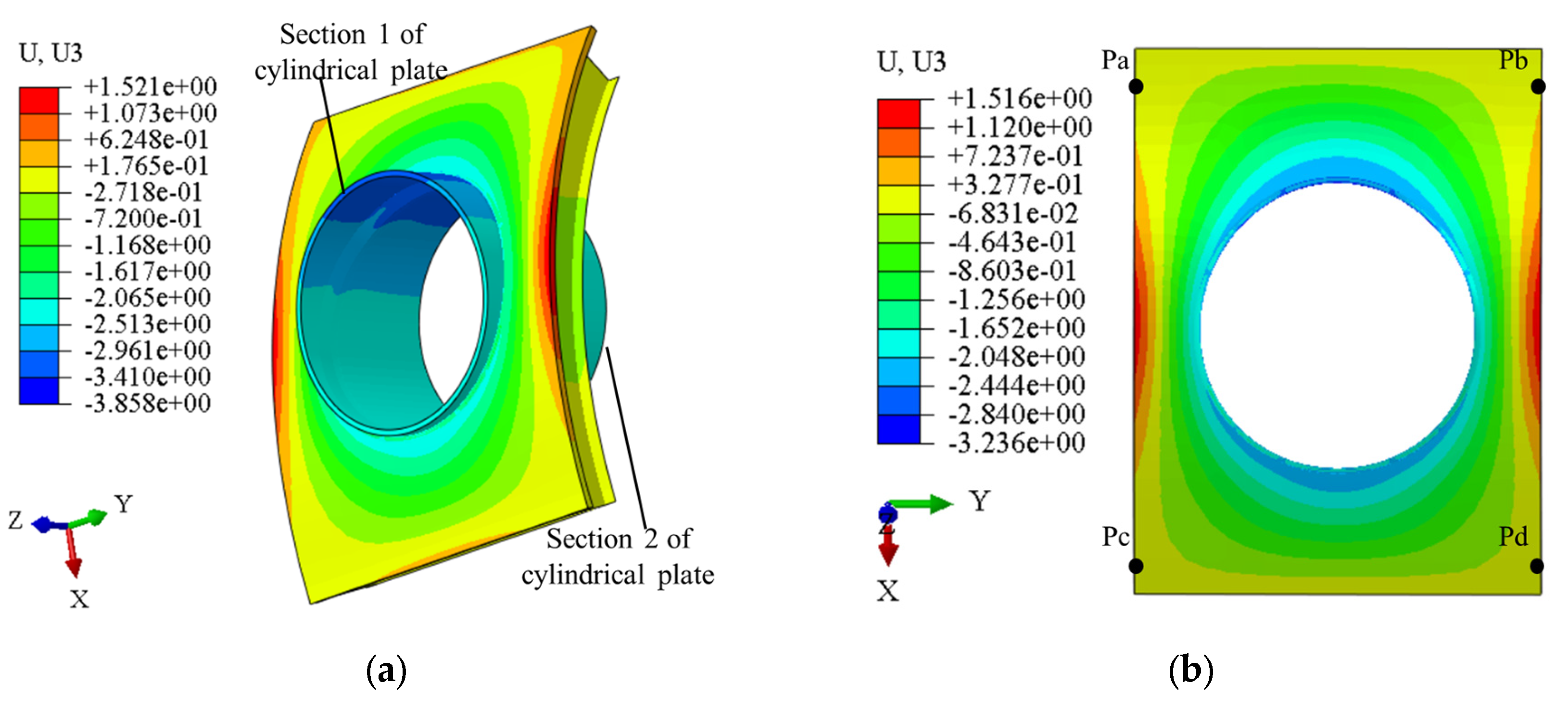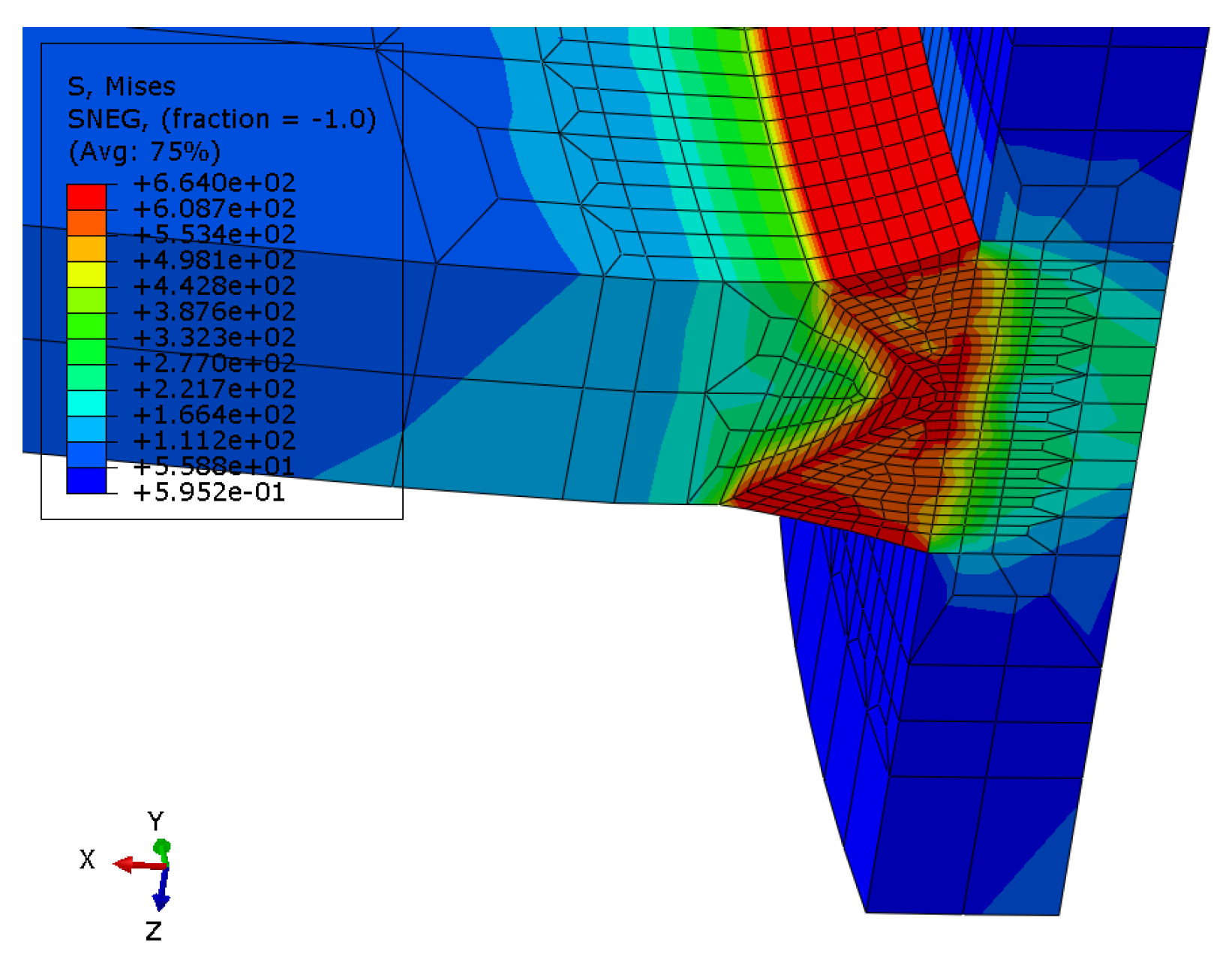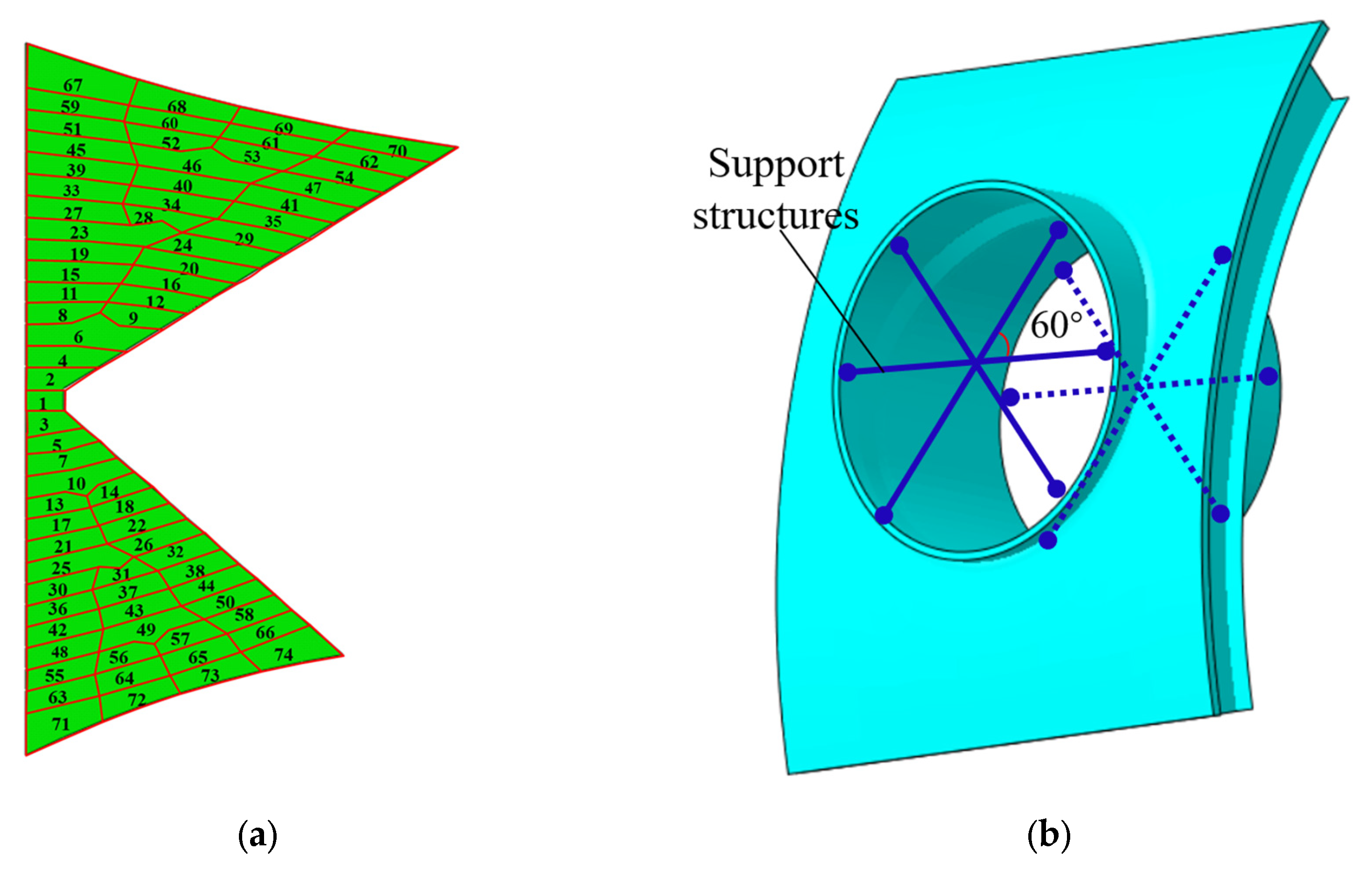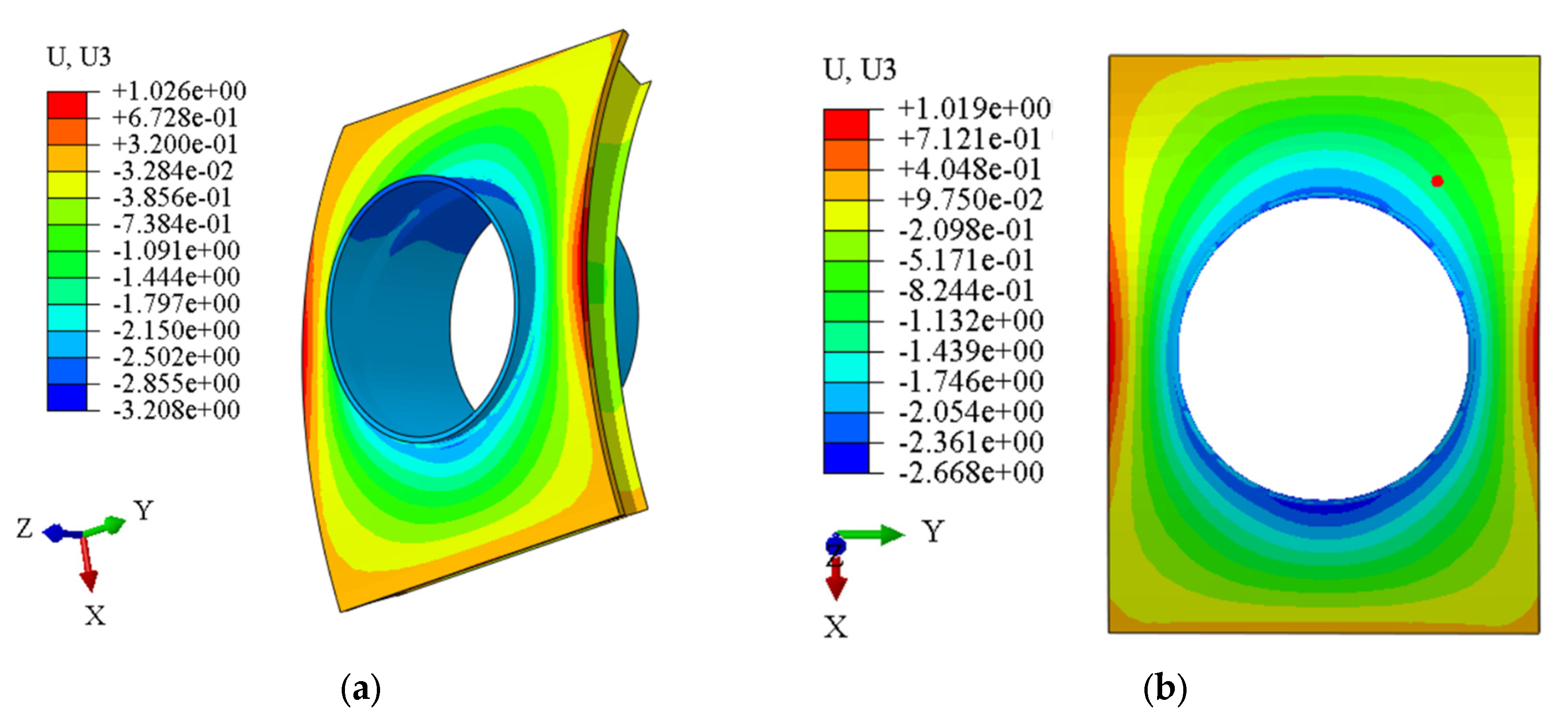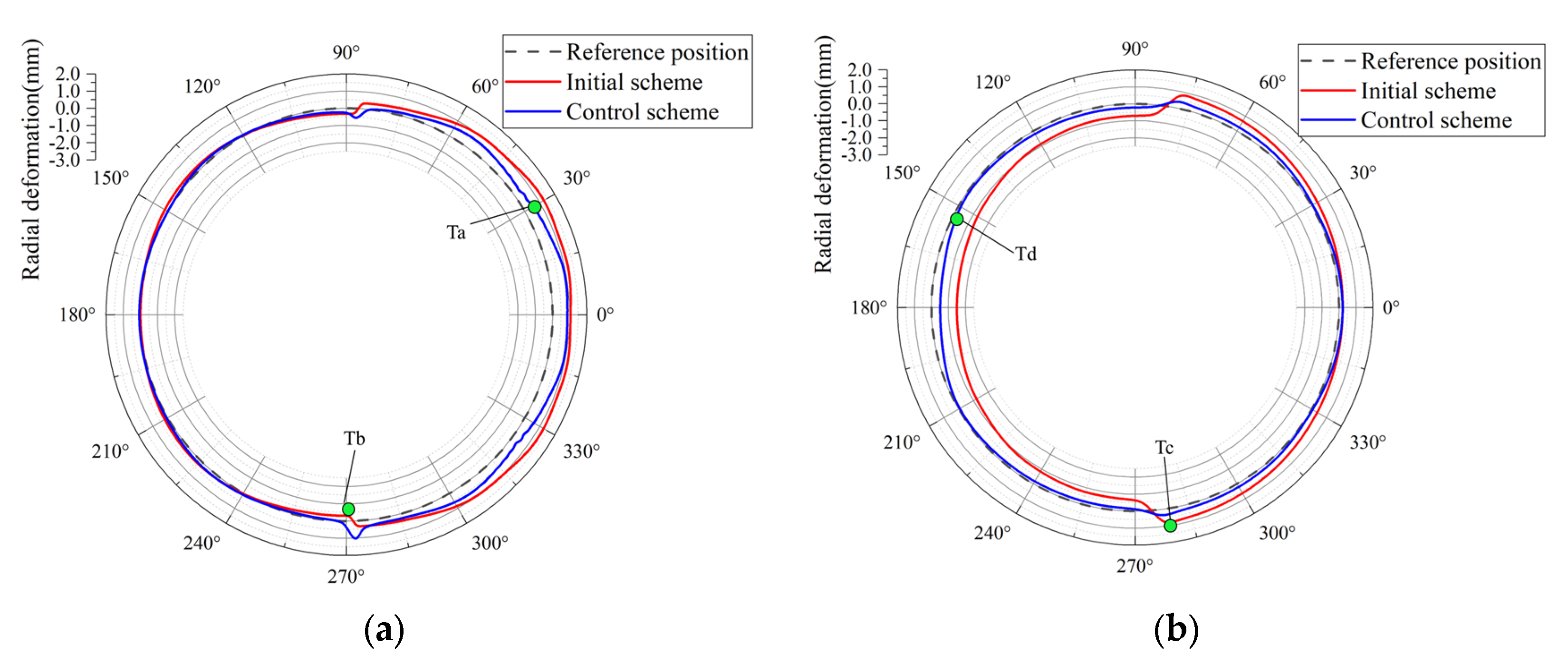1. Introduction
Stiffened curved panels and cylindrical shells are the critical load-bearing components in submarine hulls, offshore platforms, and aerospace structures. These structural members are generally connected by using welding technology. The welding process inevitably induces structural deformation and residual stress due to localized non-uniform thermal expansion and contraction of the metal adjacent to the weld in heating and cooling phases [
1]. These imperfections may degrade the mechanical properties, such as fatigue life and buckling resistance. In addition, severe welding deformation adversely affects both the visual appearance and assembly accuracy of the components [
2]. For complex hybrid structures, experimental testing of multi-pass welding processes is economically prohibitive due to the exorbitant time and financial expenditures. Fortunately, numerical simulation of welding emerges as a viable alternative, providing a cost-efficient approach for predicting structural deformations. By implementing thermo-mechanical simulations prior to actual construction, manufacturers are able to identify the distortion severity and refine the welding procedure to minimize rework.
Over the past decades, numerical simulation has significantly enhanced our ability to understand and predict welding-induced structural deformation. Choobi et al. [
3] applied a thermo-elasto-plastic finite element method (FEM) to calculate the welding deformation in a 2 mm thick 304 stainless steel butt joint. Their results showed good agreement between the predicted angular distortion and experimental measurements. Based on the ABAQUS software platform, Long et al. [
4] developed a thermo-elasto-plastic FEM to predict the mechanical responses of thin-plate butt joints induced by welding. Murakawa et al. [
5] and Nishikawa et al. [
6] developed an iterative substructure method for thick-plate welding simulation by dividing the finite element model into plastic/elastic zones. During iterative calculations, only the plastic zone is processed, thereby significantly enhancing computational efficiency in numerical simulation. In addition, Zhou et al. [
7] investigated the welding-induced radial deformation in ring-stiffened cylindrical shells through an integrated computational approach.
The thermo-elasto-plastic FEM can accurately simulate the welded joints but faces challenges in large-scale structures due to the high computational costs. To overcome these limitations, Chen et al. [
8] proposed a shell–solid mixed modeling approach, while Perić et al. [
9] demonstrated a shell–solid hybrid element for modeling T-joints, both achieving experimental validation with improved computational efficiency. Zhou et al. [
10] developed a thermo-elasto-plastic FEM incorporating an iterative substructure method and multi-core parallel computing technology. This method enables addressing the strong nonlinearities inherent in welding mechanical responses while considerably enhancing the computational efficiency. For thermo-elasto-plastic FEM, another approach to improve the computational efficiency is to adopt simplified heat source models. Kiyoshima et al. [
11] successfully improved the efficiency by replacing the Gaussian heat source with segmented volumetric heat flux.
Control of welding-induced deformation constitutes a fundamental consideration in structural fabrication processes. Current methods primarily focus on optimizing welding sequences and applying mechanical constraints, both widely proven in industry applications. Fu et al. [
12] reported that clamp–release boundary conditions significantly reduce the deformation in T-joints, whereas Desai and Bag [
13] reported higher residual stress near constrained zones in micro-spot laser welds compared to free-state conditions. Combining experimental and numerical analysis, Wang et al. [
14] established that web-first welding can minimize the distortion in H-type Q345 steel butt joints. Wang et al. [
15] proposed that the preset reverse deformation, optimized welding sequences, and external constraints can effectively reduce transverse bending and angular distortion in I-section cantilever beams. Zhang et al. [
16] proved that edge constraints and preset reverse deformation can reduce angular distortion yet marginally affect residual stress in multi-pass spherical joints. Yi et al. [
17] also showed significant reduction in welding deformation using edge constraints and rigid cylindrical supports in propeller base structures. In addition to the aforementioned deformation control measures, scholars have also investigated the effectiveness of other approaches, such as the reverse pre-deformation method [
16,
18] and post-weld heat treatment [
19], in reducing the welding distortion.
The literature reveals a predominant focus on welding deformation in simple structures, with limited attention to multi-pass welded complex assemblies. To this end, this paper investigates the prediction and control of welding deformation in a stiffened curved panel–cylindrical shell hybrid structure. The complete welding process is simulated using the sequential coupled thermo-elasto-plastic finite element method. The shell–solid mixed modeling approach and the segmented moving heat source model are employed to accelerate the multi-pass welding simulation. Furthermore, the effectiveness of optimized weld pass sequences and support structures in controlling welding deformation is investigated. Comparative analysis of the two constraint schemes revealed significant deformation reduction through structural optimization.
2. Structural Arrangement and Welding Procedure
The investigated structure is shown in
Figure 1. This structure integrates three key components: a curved base plate measuring 5000 mm in length, 4000 mm in width, and 80 mm in thickness; a cylindrical shell with 2500 mm diameter, 1800 mm axial length, and 60 mm wall thickness; and an array of orthogonal stiffeners with 142 mm height welded to the curved panel. Note that the curved panel and longitudinal stiffeners maintain longitudinal curvature while remaining straight in the transverse direction. In addition, the cylindrical shell penetrates through the central region of the stiffened curved panel, with its axis oriented at an angle relative to the surface normal at the panel’s geometric center. The three components exhibit fundamentally different geometries and deliver complementary structural performance characteristics. Their manufacturing process is much more complex compared to conventional simpler structures, justifying the classification of their assembly as a hybrid structure. The geometric features of this assembly are comparable to those found in many engineering applications, such as ship pipelines, submarine pressure hulls, wind turbine towers, and reactor pressure vessels. Therefore, the welding methodology presented in this study can provide valuable references for manufacturing these structures. The base material of the hybrid structure is high-strength steel DP980. The temperature-dependent thermal and mechanical properties of the material of this steel are presented in
Figure 2 [
20,
21].
This study primarily examines the structural deformation induced by the complex spatial annular weld between the cylindrical shell and the curved panel. Such a weld type, commonly employed in shipbuilding and aircraft structures, presents significantly greater complexity than conventional linear weld. It poses substantial challenges in both practical welding operations and numerical simulations. From a computational perspective, the main difficulties lie in finite element modeling of the curved joint geometry and accurate heat source application along the three-dimensional weld path. The welds between the curved panel and stiffeners fall outside the present research scope, as this traditional joint configuration has been extensively investigated in the prior literature. To accommodate the thick-plate configuration, a K-groove joint design is employed which can ensure optimal weld quality and connection strength. The groove features 68 mm and 50 mm upper and lower openings, respectively; see
Figure 1a. The multi-pass welding is completed using Shielded Metal Arc Welding (SMAW). Despite its higher cost, this approach is still the current solution for the welds of three-dimensional complex structures, since advanced robotic technology may not yet be well-suited for welding such intricate geometries.
4. Prediction of Welding Deformation
4.1. Preliminary Design of Welding Process
Before applying the segmented moving heat source, the curved panel and cylindrical shell are temporarily joined by tack welds to maintain dimensional stability during fabrication. A total of 74 weld seams are carefully designed for the K-groove joint. This joint can be regarded as a double-sided double-bevel groove. The welding sequence for all passes is presented in
Figure 6a, which is denoted by the numerical order. As indicated in
Figure 6a, the preliminary welding scheme employs a globally symmetric welding sequence with local asymmetric variations. The welds on both sides are divided into three major zones, where symmetry is maintained at the zonal level but not at individual layers. In the next section, the welding sequence will be further optimized at the individual layers. Prior to heating the subsequent weld bead, the current bead is cooled to a specified temperature through dedicated cooling analysis steps.
A coordinated four-operator simultaneous welding approach is employed, in which travel directions are systematically arranged according to symmetry principles, as illustrated in
Figure 6b. It is well known that symmetric welding path planning also contributes to welding distortion mitigation for circular or cylindrical structures. Note that no external fixturing is applied during welding in terms of the preliminary procedure, and distortion control is achieved solely through the inherent stiffness determined by the pre-assembled structure. The welding procedure specifications, including essential parameters such as current, voltage, and travel speed, are documented in
Table 1.
Summing the time of all analysis steps yields the total duration of the welding simulation in ABAQUS software, which is 64,542 s. In practice, a single load case requires more than one week of continuous computational runtime to complete the temperature and stress analyses. If a transient moving heat source is adopted, the simulation time will far exceed one week. It should be noted that the iterative cooling time of the structure after completion of all weld passes is 4000 s. For all heating steps, the time increment between adjacent substeps is automatically determined by the software, which is generally below 0.1 s.
4.2. Finite Element Model
The finite element model of the hybrid structure is accurately modeled in PATRAN 2019 software based on its geometric dimensions. This model is subsequently transferred to ABAQUS 2023 software for welding simulation. In this model, the curved panel, cylindrical shell, and weld seams are discretized using solid elements, while the transverse and longitudinal stiffeners are modeled employing shell elements. More specifically, DC3D8 and C3D8R are selected as the types of solid elements during thermal analysis and mechanical analysis, respectively. DS4 and S4R are selected as the types of shell elements in these two steps, respectively. It is crucial to emphasize that welding simulations necessitate refined mesh resolution in the weld region, irrespective of the overall structural dimensions, due to the presence of steep thermal gradients. To improve computational efficiency while maintaining simulation accuracy, the finite element model implements a non-uniform meshing strategy. This approach utilizes an element size of 3.0 mm × 3.0 mm × 3.0 mm in the weld zone to precisely resolve these gradients, while progressively coarsening element sizes in regions are farther from the heat-affected zone. The cross-section of each weld bead, measuring approximately 8.0 mm, is represented by 2–3 finite elements. Such a size is consistent with that of the heat source, which is roughly equal to 13% of the wall thickness. The final finite element model consists of 286,125 nodes and 372,487 elements.
Figure 7 displays the complete mesh distribution of the finite element model.
As mentioned previously, the stiffeners are modeled using shell elements. Because their locations experience minimal thermal effects during welding, it means that strain levels due to welding are insufficient to induce plastic deformation at these locations. The reinforcing components primarily function to enhance structural rigidity against welding-induced distortion. Another point is that the adoption of shell elements significantly reduces modeling complexity at the curved panel–stiffener interfaces. To achieve effective load transfer between these two structural components, a shell-to-solid coupling method provided by the ABAQUS software is implemented in the welding simulation.
In the preliminary welding procedure, the finite element model neglects artificial fixation constraints that could influence the deformation pattern. To ensure numerical convergence while maintaining the unconstrained nature of the physical setup, three-point constraints are implemented at three nodes of the model, as illustrated in
Figure 7. In the figure, UX, UY and UZ respectively represent displacement constraints in the x-direction, y-direction and z-direction. The applied boundary conditions only enable eliminating rigid body motion degrees of freedom during computation.
Figure 8 shows the temperature variation at the weld zone during the welding process and the final temperature distribution of the hybrid structure after cooling. As can be seen, the peak temperature reaches approximately 2500 °C in the weld pool filling stage, while during the cover pass welding, the maximum temperature decreases to about 1500 °C. After complete cooling, the final temperature of the entire structure falls below 28 °C.
4.3. Welding Deformation Results
In this subsection, the structural deformation results based on spatial multi-pass welding simulation are considered, which correspond to the preliminary welding procedure. The results indicate that the dominant deformation modes of the hybrid structure are manifested as the out-of-plane deformation of the curved panel and cylindrical shell together with the radial deformation of the latter member. Characteristics of the two kinds of structural deformation are analyzed below.
- (a)
Out-of-plane deformation
The out-of-plane deformation distribution of the stiffened curved panel is presented in
Figure 9a. Herein, the welding deformation is defined as node dislocation. As shown, the long-edge regions exhibit significant positive z-direction deformation, while areas near the weld seams display prominent negative z-direction deformation, with a maximum relative deviation of 4.8 mm. The out-of-plane deformation of the stiffened curved panel likely originates from angular distortions at the welded joint, where successive weld passes induce significant through-thickness temperature gradients between the upper and lower surfaces. Notably, the deformation magnitude varies along the long free edge, being relatively smaller near the intersections of transverse and longitudinal stiffeners (points Pa, Pb, Pc, and Pd); see
Figure 9b. This indicates that applying constraint supports along the free edge helps suppress the overall structural deformation.
In terms of the cylindrical shell, it deforms mainly in the negative z-direction, and the maximum displacement occurs near the negative x-axis. The cylindrical shell shows larger z-direction deformation than the stiffened curved panel. This difference likely stems from fewer supporting members. Nevertheless, the overall out-of-plane deformation of the integrated model remains relatively small (<5 mm), primarily due to the great thicknesses of both structural components, which provides enhanced structural stiffness.
- (b)
Radial deformation
The two end sections of the cylindrical shell described in
Figure 9a are selected to examine the radial deformation. Obviously, the cylindrical coordinate system is more suitable than the Cartesian coordinate system for describing the radial deformation. Accordingly, a local cylindrical coordinate system is defined at the center of the cylindrical shell, as shown in
Figure 10. It should be noted that the symbols “T”, “R”, and “Z” denote the axial, radial, and circumferential directions of the cylindrical shell. Herein, the axial deformation is actually equivalent to the z-direction deformation which has been presented previously. It is known from the geometric features of circular structures that the circumferential deformation is closely related to the radial deformation. Therefore, the latter is discussed in detail as follows.
Figure 10 illustrates the radial deformation distribution of the two sections after welding. Herein, the deformation is magnified by a factor of 50 to enhance visibility. It is apparent that the ends of the cylindrical shell deform into an elliptical geometry. The two end sections exhibit opposite-phase radial deformation patterns: Section 1 demonstrates outward expansion along the longitudinal direction, whereas Section 2 undergoes inward contraction. The relative magnitudes of the radial deformation are 3.7 mm for Section 1 and 3.1 mm for Section 2, respectively. Welding deformation is often accompanied by residual stress.
Figure 11 shows the distribution of such imperfections around the weld seam after cooling. It can be observed that the maximum von Mises stress reaches 664 MPa appearing in the weld beads, while the stress amplitude is lower in areas farther away from these regions. In the subsequent analysis, constrained boundary conditions will be incorporated to mitigate the radial deformation.
